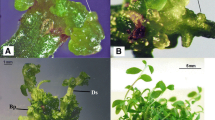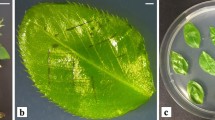Abstract
Establishment of a stable and efficient in vitro regeneration system from leaf explants is a basic requirement for success in genetic transformation of peach. In this study, approximately 900 leaf explants of ‘Guardian®’ peach genotype were separated from in vitro shoots and cultured for shoot regeneration on ½ MS medium with different doses and combinations of thidiazuron (TDZ) and silver thiosulphate (STS). The results showed that callus bud formation and shoot regeneration occurred 4 and 6 weeks after culture initiation, respectively. All the regenerated shoots were from petioles of the leaf explants. Regeneration rates were significantly affected by different combinations of TDZ and STS (P < 0.05). Separation of means by Tukey test method revealed that on half strength MS media, high regeneration rates were obtained from the combinations of 6.81 µM TDZ + 10 µM STS, and of 9.08 µM TDZ + 10 µM STS (16 and 14 %, respectively). The number of shoots per regenerating explants was also significantly affected by growth regulator concentrations. The highest shoot number was obtained with the combination of 6.81 µM TDZ + 10 µM STS. Rooting percentage varied from 85 to 100 % depending on plant growth regulator used. On half strength MS medium containing 1.0 mg/l of IBA, an average of 7 roots per regenerating shoot was produced. The rooted plantlets were successfully acclimatized with 92 % survival rate under greenhouse conditions. This established regeneration system from leaf explants would facilitate the development of reliable peach genetic transformation procedures, helping accelerate peach genetic improvement using biotechnology approaches.






Similar content being viewed by others
Abbreviations
- BAP:
-
6-Benzylaminopurine
- GA3 :
-
Gibberellic acid
- IBA:
-
Indole butyric acid
- MS:
-
Murashige and Skoog medium
- NAA:
-
Naphthalene acetic acid
- STS:
-
Silver thiosulfate
- TDZ:
-
Thidiazuron
References
Ainsley PJ, Hammerschlag FA, Bertozzi T, Collins GG, Sedgley M (2001) Regeneration of almond from immature seed cotyledons. Plant Cell Tissue Organ Cult 67:221–226
Alburquerque N, Burgos L (2003) Ethylene inhibitors and low kanamycin concentrations improve adventitious regeneration from apricot leaves. Plant Cell Rep 21:1167–1174
Beyer EM (1979) Effect of silver ion, carbon dioxide and oxygen on ethylene action and metabolism. Plant Physiol 63:169–173
Caboni E, Tonelli MG, Lauri P, Kevers C, Damiano C, Gaspar T (1997) Biochemical aspects of almond microcuttings related to in vitro rooting ability. BiologiaPlantarum 39:91–97
Caboni E, Tonelli MG, Lauri P, Angeli SD, Damiano C (1999) In vitro shoot regeneration from leaves of wild pear. Plant Cell Tissue Organ Cult 59:1–7
Caudle N (2012) The sweet spot. In: Glimpse: research and creative discovery at Clemson University. Spring 2012, vol 1. Clemson University, Clemson, SC, pp 26–29
Feeney M, Bhagwat B, Mitchell JS, Lane WD (2007) Shoot regeneration from organogenic callus of sweet cherry (Prunusavium L.). Plant Cell Tissue Organ Cult 90:201–214
Feng JC, Yu XM, Shang XL, Li JD, Wu YX (2010) Factors influencing efficiency of shoot regeneration in Ziziphusjujuba Mill. ‘Huizao’. Plant Cell Tissue Organ Cult 101:111–117
Fotopoulos S, Sotiropoulos TE (2004) In vitro propagation of the peach rootstock: the effect of different carbon sources and types of sealing material on rooting. BiologiaPlantarum 48(4):629–631
Gentile A, Monticelli S, Damiano C (2002) Adventitious shoot regeneration in peach (Prunuspersica (L.) Batsch). Plant Cell Rep 20:1011–1016
Hammerschlag FA, Bauchan G (1984) Genetic stability of calluscells derived from peach embryos. HortScience 19:554
Kalinina A, Brown DCW (2007) Micropropagation of ornamental Prunusspp. and GF305 peach, a Prunus viral indicator. Plant Cell Rep 26:927–935
Koubouris G, Vasilakakis M (2006) Improvement of in vitro propagation of apricot cultivar ‘Bebecou’. Plant Cell Tissue Organ Cult 85:173–180
Kramarenko LA (1999) Micropropagation of apricot and field performance of in vitro propagated plants. ActaHorticulturae 488:417–420
Leva AR, Roselli G, Fabbri A, Lisetti M (1990) Somatic embryogenesis in Prunuspersica and hybrids with Prunusdavidiana. XXIIIrd international ISHS congress, Firenze, Italy: 3130. Post
Liu X, Pijut PM (2008) Plant regeneration from in vitro leaves of mature black cherry (Prunusserotina). Plant Cell Tissue Organ Cult 94:113–123
Mante S, Scorza R, Cordts JM (1989) Plant regeneration from cotyledons of Prunuspersica, Prunusdomestica and Prunuscerasus. Plant Cell Tissue Organ Cult 19:1–11
Morini S, Perrone S (2006) Effect of short light-darkregimes on in vitro shoot rooting of some fruit tree rootstocks. BiologiaPlantarum 50:429–432
Nas MN, Bolek Y, Sevgin N (2010) The effects of explant and cytokinin type on regeneration of Prunusmicrocarpa. ScientiaHorticulturae 126:88–94
Okie WR, Reighard GL, Beckman TG, Nyczepir AP, Reilly CC, Zehr EI, Newall WC, Cain DW (1994) Field-screening Prunus for longevity in the Southeastern United States. HortScience 29:673–677
Perez-Jimenez M, Carrillo-Navarro A, Cos-Terrer J (2012) Regeneration of peach (Prunuspersica L. Batsch) cultivars and Prunuspersica X Prunusdulsisrootstocks via organogenesis. Plant Cell Tissue Organ Cult 108:55–62
Perez-Tornero O, Lopez JM, Egea J, Burgos L (2000) Effect of basal media and growth regulators on the in vitro propagation of the apricot cultivar ‘Canino’. J Hortic Sci Biotechnol 75:283–286
Petri C, Scorza R (2010) Factors affecting adventitious regeneration from in vitro leaf explants of ‘Improved French’ plum, the most important dried plum cultivar in the USA. Ann Appl Biol 156:79–89
Raj Bhansali R, Driver JAA, Durzan DJ (1990) Rapid multiplication of adventitious somatic embryos in peach and nectarine by secondary embryogenesis. Plant Cell Rep 9:280–284
Sarropoulou VN, Therios IN, Dimassi-Theriou KN (2012) Melatonin promotes adventitious root regeneration in in vitro shoot tip explants of the commercial sweet cherry rootstocks CAB-6P (Prunuscerasus L.) Gisela 6 (P. cerasus x P. canencens), and MxM 60 (P. avium x P. mahaleb). J Pineal Res 52:38–46
Scorza R, Cordts JM, Mante S (1990) Long-term somatic embryo production and regeneration from embryo-derived peach callus. Proc Int Symp In Vitro Cult Hortic Breed ActaHort 280:183–190
Tereso S, Miguel CM, Mascarenhas M, Roque A, Rtindade H, Maroco J, Oliveira MM (2008) Improved in vitro rooting of Prunusdulsis Mill. cultivars. BiologiaPlantarum 52(3):437–444
Tian L, Wen Y, Jayasankar S, Sibbald S (2007) Regeneration of PrunussalicinaLindl (Japanese plum) from hypocotyls of mature seeds. In vitro Cell Dev Biol 43:343–347
Wang H, Alburquerque N, Burgos L, Petri C (2011) Adventitious shoot regeneration from hypocotyl slices of mature apricot (Prunusarmeniaca L.) seeds: a feasible alternative for apricot genetic engineering. ScientiaHorticulturae 128:457–464
Welander M (1983) In vitro rooting of the apple rootstock M26 in adult juvenile and growth phases and acclimatization of the plantlets. Physiol Plant 58:231–238
Yepes LM, Aldwinckle HS (1994) Micropropagation of thirteen Malus cultivars and rootstock and effect of antibiotics on proliferation. Plant Growth Regul 15:55–67
Zhou H, Li M, Zhao X, Fan X, Guo A (2010) Plant regeneration from in vitro leaves of the peach rootstock ‘Nemaguard’ (Prunuspersica x P. davidiana). Plant Cell Tissue Organ Cult 101:79–87
Acknowledgments
This work was supported by South Carolina Peach Council, and the U.S. Department of Agriculture Cooperative State Research, Education, and Extension Service (Grant Nos. SC1700315 and SC-1700450). Bekir San was supported by a fellowship from the Scientific and Technological Research Council of Turkey (TUBITAK). This is Technical Contribution No. 6294 of the Clemson University Experiment Station.
Author information
Authors and Affiliations
Corresponding author
Rights and permissions
About this article
Cite this article
San, B., Li, Z., Hu, Q. et al. Adventitious shoot regeneration from in vitro cultured leaf explants of peach rootstock Guardian® is significantly enhanced by silver thiosulfate. Plant Cell Tiss Organ Cult 120, 757–765 (2015). https://doi.org/10.1007/s11240-014-0645-7
Received:
Accepted:
Published:
Issue Date:
DOI: https://doi.org/10.1007/s11240-014-0645-7




